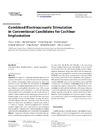Please use this identifier to cite or link to this item:
https://accedacris.ulpgc.es/jspui/handle/10553/76787
| Title: | Combined electroacoustic stimulation in conventional candidates for cochlear implantation | Authors: | James, Chris J. Fraysse, Bernard Deguine, Olivier Lenarz, Thomas Mawman, Deborah Ramos Macías, Ángel Ramsden, Richard Sterkers, Olivier |
UNESCO Clasification: | 321305 Cirugía de garganta, nariz y oídos | Keywords: | Cochlear implant Residual hearing Speech recognitioni in noise |
Issue Date: | 2006 | Publisher: | Karger | Journal: | Audiology and Neuro-Otology | Conference: | 1st International Electro-Acoustic Workshop. Cochlear implantation | Abstract: | Objective: To report on combined ipsilateral electrical and acoustic stimulation in a subset of conventional candidates for cochlear implantation where preoperative pure tone thresholds were ≤60 dB HL for 250 and 500 Hz. Methods: Subjects were 10 adults implanted with the Nucleus 24 Contour Advance perimodiolar electrode array. Soft surgical procedures were strictly observed: ≤1.5-mm cochleostomy hole placed anterior and inferior to the round window, a Healon bubble placed over the opening to prevent entry of foreign bodies, and no suction applied. The electrode array was inserted 17 mm to the first marker rib using the recommended 'advance-off-stylet' technique. Pure tone hearing threshold levels were recorded pre-, and postoperatively at 1-2 and 6-12 months. Speech recognition was tested for cochlear implant (CI) alone and combined with ipsilateral hearing aid for 7 subjects who retained significant residual hearing in the implanted ear at 1-2 months after operation. Results: There were 3/10 cases where 1-2 months after operation low-frequency responses were considered vibrotactile only (>85-110 dB HL, 250-500 Hz). In the remaining 7 cases, residual hearing was maintained up to at least 6 months after operation with minor changes. Insertion depth angles in these cases ranged from 285 to 420°. For these subjects, the mean preoperative score for words presented at 65 dB SPL was 22%. Mean postoperative scores were 56% for CI alone, and 68% for CI plus ipsilateral hearing aid (p < 0.05, paired t). For sentences presented in multitalker babble noise at 5 dB SNR, mean scores were 61% CI alone, and 75% CI+IpsiHA (p < 0.01, paired t). Conclusions: Hearing was conserved during surgery and over time in 70% of conventional candidates implanted with the Nucleus 24 Contour Advance CI who had significant levels of preoperative low-frequency residual hearing (≤60 dB HL). These conventional candidates for CI also benefited from improved speech recognition in noise when using combined ipsilateral electrical and acoustic stimulation. | URI: | https://accedacris.ulpgc.es/handle/10553/76787 | ISBN: | 978-3-8055-8212-4 | ISSN: | 1420-3030 | DOI: | 10.1159/000095615 | Source: | Audiology and Neurotology [ISSN 1420-3030], v. 11 (SUPPL. 1), p. 57-62, (Octubre 2006) |
| Appears in Collections: | Actas de congresos |
SCOPUSTM
Citations
86
checked on Jun 8, 2025
Page view(s)
176
checked on Jan 6, 2024
Download(s)
257
checked on Jan 6, 2024
Google ScholarTM
Check
Altmetric
Share
Export metadata
Items in accedaCRIS are protected by copyright, with all rights reserved, unless otherwise indicated.
